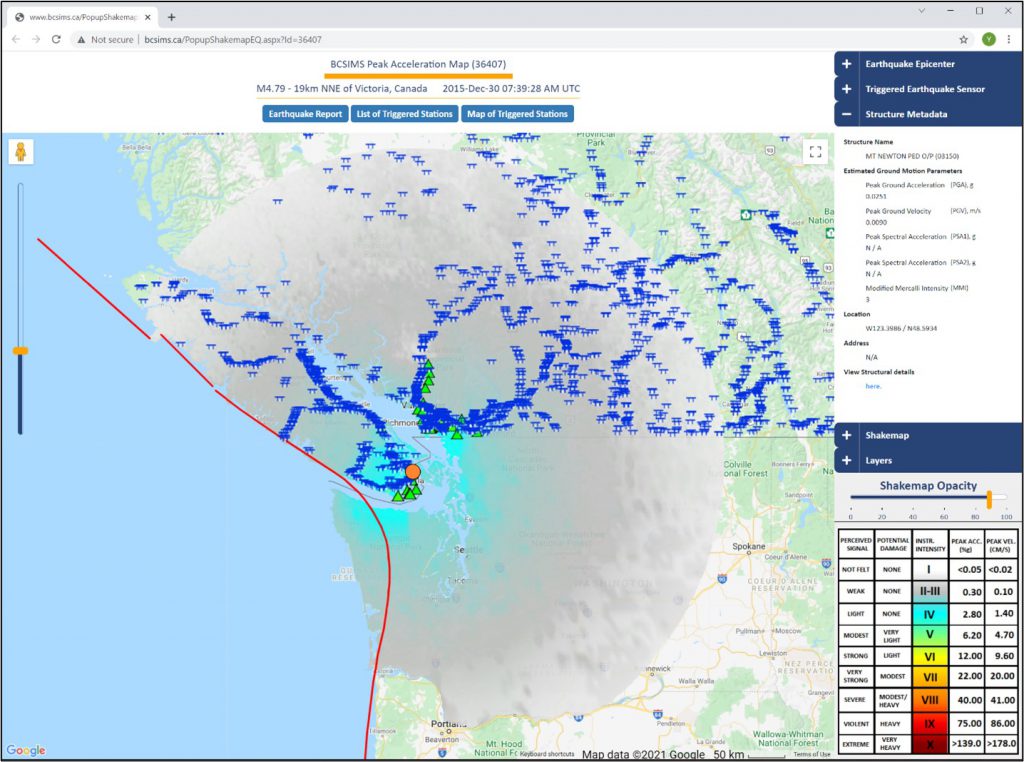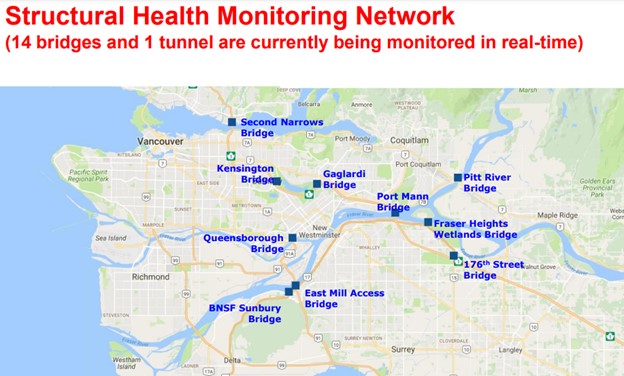 Hello.
Hello.
My name is British Columbia Smart Infrastructure Monitoring System. My developers call me BC SIMS.
My job is to constantly monitor seismic activity across Canada (as well as Washington, Oregon and Alaska) and report any tremors to Ministry of Transportation and Infrastructure engineers to help them keep BC highways safe and running smoothly following a damaging earthquake. There are over 100 earthquakes in BC every day, which is why I am an important part of the Ministry Transportation and Infrastructure’s seismic engineering toolkit.
My system is made up of two unique parts – the Strong Ground Motion Network and the Structural Health Monitoring Network. Allow me to describe the function of each of my parts below.
Strong Ground Motion Network
This network consists of approximately 160 earthquake sensors, installed at or near critical infrastructure locations (such as public schools, government offices, fire halls, BC ambulance stations, bridges, etc.,) in earthquake prone areas of the province. These sensors monitor and record seismic activities in real-time at and around their locations. Once trigged by an earthquake, sensors will immediately report the level of shaking to the BC SIMS data centre, which will trigger the system to automatically generate an earthquake report and shake-map for ministry staff and registered users of the BCSIMS webpage.
An automated service sends out immediate earthquake notifications by e-mail to registered users of the BCSIMS network. Earthquake activities are immediately posted on the BC SIMS webpages, along with the data listed below:
- Earthquake magnitude
- Location of the earthquake
- Depth of the earthquake
- Date & time of the earthquake
- Region
Ministry engineers use these reports and maps to compare the earthquake event with the seismic threshold that specific structures, such as bridges and tunnels, are designed to withstand. These tools help engineers and emergency managers get a quick idea of where the strongest motion occurred so they can identify priority sites and focus resources there.

Structural Health Monitoring Network
This important network of sensors monitors earthquake vibration levels on critical ministry infrastructure. The objective of the Structural Health Monitoring (SHM) system is to provide the ministry (and the public) with data for these structures immediately after a significant event, in order to assess the safety level of these infrastructures. When a tremor is registered by a bridge, a report is generated highlighting the intensity and expected damage and sent to ministry engineers and inspectors immediately for their review.
If an earthquake event is greater than 6 on the Richter Scale, an email will be sent to all ministry staff asking them to confirm their location, job title and availability for work. This information will be used to make strategic decisions and deploy staff for response.
The ministry has been working collaboratively with UBC on this network since the late 1990s and there are currently 14 bridges and 1 tunnel in the network and the number of monitored structures within the system is expected to increase in the upcoming years. The ministry has also used this system with great success during ministry emergency training events and it also helps support the inspection and maintenance of these critical structures as well as helps with retrofit efforts, as required.

Thank you for taking the time to review my system parameters. I hope this information is helpful.
BC SIMS has been developed to be used by a wide range of users – local governments, emergency authorities, engineering specialists – anyone with an interest in local infrastructure is encouraged to join the network. Registration for the earthquake notification service is open to public from the BC Smart Infrastructure Monitoring System (BCSIMS) website.
Did you enjoy reading this blog? Check out these related topics:
- How Our Structural Engineering Team Helps Keep BC Moving
- Six Types of BC Bridges Identified
- How to Pack Your Emergency Vehicle Kit in 15 Seconds
- Are BC Highways Prepared for Earthquakes?
If you have any questions about this or anything else the BC Ministry of Transportation and Infrastructure does, leave a comment in the section below.
Do you guys have any opportunity for a seismologist with lots of experience in ground motion analysis and earthquake monitoring?
Hi Ali – thanks for your interest. We encourage you to visit the government hiring site for our current opportunities: https://www2.gov.bc.ca/gov/content/careers-myhr/job-seekers/current-job-postings
Suggestions can you open all drains allowing melted snow a place to go.Can you remove slush from intersection with shovels .As A child that grew up with same bad weather I know that a better job could be done . I would gladly take a job to coordinate this plan.
Hello Denise – thanks for your comment. Could you clarify which drains you are referring to? More information would help us know where we need to follow up. Thanks!
If you are going to keep telling people to rely on and check Drive BC , perhaps you could update it when you say you will. For instance, at this moment 14:45pm Nov 21 ;hwy 1 on drive bc says next update 7am Nov21. This happens far to often. Especially on weekends when the public and professional drivers need the information
Hello there Michael – thanks for your comment. We understand the importance of these updates, especially during emergency situations and we do everything we can to remain on top of them; however, some times the information for an update comes from staff in the field and who can sometimes be delayed by the activity of the event itself. We appreciate your patience and understanding. We want you to be as well informed as possible. 🙂
Hi there…just read these two comments. My recommendation would be that if an update is promised by a certain date/time, if there is truly IS no update, simply state that (ideally with reasons) and provide a new expected update time/date. I understand the reasons why some updates may not be readily available, however, if nothing is stated and a time/date expires, the perception by the public is that this was ‘a miss’. At least with SOMEthing there, we are aware things have not been forgotten about.
Thanks for your comment, Kevin. We understand your concerns and our staff are also aware of public perception on the time updated topic. They do everything they can to provide updates when promised, but this is not always possible. Here’s a link to a blog that explains how DriveBC is updated: https://www.tranbc.ca/2015/07/17/how-information-is-updated-on-drivebc-and-why-you-might-notice-a-delay/